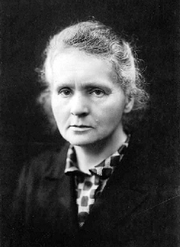Polish-French Chemist and Physicist, famous for pioneering work on Radioactivity
Marie Skłodowska Curie (7 November 1867 – 4 July 1934), was born in Warsaw, Poland. She was a chemist and physicist famous for her pioneering work on radioactivity. Although her work brought about her death, it led to the discovery of cancer treatments, saving countless lives.
Marie Curie was married to a fellow scientist, Pierre Curie, and mother of Irène Joliot-Curie and Ève Curie. Despite being barred from higher education due to her sex, Curie pursued her studies at the clandestine "Flying University," where she laid the foundation for her revolutionary discoveries of radium, polonium, and the concept of radioactivity.
Irene followed in her parents' footsteps also becoming a Nobel laureate in Chemistry (1935) with her husband Frédéric Joliot-Curie. Eve (Ève Denise Curie Labouisse) was a writer, journalist and pianist. Ève was the only member of her family who did not choose a career as a scientist, however, her husband Henry Richardson Labouisse, Jr., American diplomat and statesman, collected the Nobel Peace Prize in 1965 on behalf of UNICEF.
Madame Curie was the first person honoured with two Nobel Prizes - in physics and chemistry. She was also the first female professor at the University of Paris and the first woman to be entombed on her own merits (in 1995) in the Paris Pantheon.
Sadly, Marie Curie’s pioneering work came at a great cost. She unknowingly exposed herself to lethal doses of radiation. The damaging effects of ionising radiation were not known at the time of her work, which had been carried out without the safety measures later developed. Tirelessly studying and working on her experiments she carried the test tubes containing radioactive isotopes in her pocket, and she stored them in her desk drawer, even remarking on the faint light that the substances gave off in the dark. She was also exposed to X-rays from unshielded equipment while serving as a radiologist in field hospitals during the war. Although her many decades of exposure to radiation caused chronic illnesses, including near blindness due to cataracts, and ultimately her death, she never really acknowledged the health risks of radiation exposure.
Today, her body and personal belongings remain radioactive and are expected to stay so for another 1,500 years, a lasting testament to her profound impact on science.

Marie Curie, Nobel Laureate in Physics (1903) and Chemistry (1911)
1. Nobel Prize in Physics (1903)
In 1903, Marie Curie shared the Nobel Prize for Physics with her husband, Pierre Curie, and Henri Becquerel: "in recognition of the extraordinary services they have rendered by their joint researches on the radiation phenomena discovered by Professor Henri Becquerel."
(Image: M. Curie Medallion, Univ. of Buffalo)
Marie Curie succeeded her husband as professor of physics at the Sorbonne in 1906, after Pierre's death. She was the first woman ever to teach there.
2. Nobel Prize in Chemistry (1911)
In 1911, she was awarded the Nobel Prize for Chemistry: "in recognition of her services to the advancement of chemistry by the discovery of the elements radium and polonium, by the isolation of radium and the study of the nature and compounds of this remarkable element."
Madame Curie spent a lot of time traveling and giving lectures.
A Memory of Remembrance - Madame Marie Curie
Madame Curie died in Sallanches, France on July 4, 1934. Eve her younger daughter wrote a notable biography of her mother, entitled Madame Curie. Her achievements remain an inspiration and legacy to those of us left behind.
A biographical film made by MGM entitled Madame Curie was produced in 1943 on the life of Marie Curie, adapted from the biography by her daughter.
Related article:
"Radioactivity at a Glance" (Apology. Sadly, the link from decodedscience.com where I wrote the article is no longer available, and I can no longer find a draft copy in my files. / Tel, 7 Nov 2022.)
Resources:
Image Credit:
Marie Curie. en.wikipedia.commons / Public Domain
Resources:
- Marie Curie - Biography. Nobelprize.org. 6 Nov 2011
- Barbara Goldsmith, Obsessive Genius: The Inner World of Marie Curie, New York, W.W. Norton, 2005.
- Eve Curie, Madame Curie: A Biography, translated by Vincent Sheean, Da Capo Press, 2001.
- Marie Curie: A Pioneer in Science. Harvard Business School. Accessed March 21, 2025
- Marie Curie: The Woman Who Revolutionised Science! (1867-1934) BMResearch. Accessed March 21, 2025.
- Naomi Pasachoff, Marie Curie and the Science of Radioactivity, New York, OUP, 1996.
Image Credit:
Marie Curie. en.wikipedia.commons / Public Domain
(c) November 7, 2012. Updated March 22, 2025. Tel. Inspired Pen Web. All rights reserved.


No comments:
Post a Comment